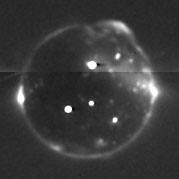Marduk (Io)
Koordinaten: 29° 17′ S, 150° 16′ O

Der Marduk ist ein Vulkan auf dem Jupitermond Io. Benannt wurde er 1979 nach der sumerischen Gottheit Marduk. In jenem Jahr wurden von der Raumsonde Voyager 1 erstmals aktive Vulkane auf Io nachgewiesen. Marduk wurde dabei als Quelle einer Eruptionssäule ausgemacht.[1]
Merkmale
Der Vulkan gilt als sehr aktiv. Die umgebende Region gilt als Hotspot. Er ist oft staubverhangen. Die ausgestoßene Lava lässt dabei Rückschlüsse auf die innere Struktur des Mondes und die auf ihn einwirkenden Kräfte zu, die für die seismischen Aktivitäten verantwortlich sind. Bei dem Vorbeiflug der Sonde Galileo im Jahr 1996 war erkennbar, dass Marduk ein Spaltenvulkan von etwa 250 km Länge ist. Von einer calderaähnlichen Senke fließen Lavaströme nach Norden in etwa 200 km ausgedehnte Lavafelder namens Marduk Fluctus.[2] Die Umgebung des Vulkans ist, vermutlich durch Ablagerungen von Schwefel, rötlich verfärbt.[1] Bei den Ausbrüchen wird sehr viel Material ausgeworfen, das im All schnell abkühlt. Vermutlich sind diese Partikel für die rote Färbung des benachbarten Mondes Amalthea verantwortlich.
Quellen
- Porträt des Vulkans im Internetauftritt des Jet Propulsion Laboratory. (englisch) abgerufen am 20. Juli 2018
- Kurzartikel über den Vulkan im Internetauftritt des Jet Propulsion Laboratory. (englisch) abgerufen am 20. Juli 2018
- Ashley Gerard Davies: Volcanism on Io. Cambridge University Press, S. 266 (englisch)
- Discovery of a Powerful, Transient, Explosive Thermal Event at Marduk Fluctus, Io, in Galileo NIMS Data. Geophysical Research Letters (englisch), abgerufen von der Homepage der Lancaster University am 21. Juli 2018
Weblinks
- Marduk im Gazetteer of Planetary Nomenclature der IAU (WGPSN) / USGS (englisch)
- Übersichtsfoto mit Marduk bei gishbartimes.org
- Übersichtskarte mit Marduk bei solarviews.com
- Io: The Fissure King? – Astronomy Picture of the Day vom 29. November 1996 (englisch).
Einzelnachweise
- ↑ a b Davies, Ashley and Davies, R. L. and Veeder, G. J. and de Kleer, K. and de Pater, I. and Johnson, T. V. and Wilson, Lionel: Discovery of a powerful, transient, explosive thermal event at Marduk Fluctus, Io, in Galileo NIMS data. In: Geophysical Research Letters, 45 (7). pp. 2926–2933. ISSN 0094-8276. 24. April 2018, abgerufen am 21. Juli 2018 (englisch).
- ↑ Marduk Fluctus im Gazetteer of Planetary Nomenclature der IAU (WGPSN) / USGS (englisch)
Auf dieser Seite verwendete Medien
Original Caption Released with Image: This image of Io eclipsed by Jupiter's shadow is a combination of several images taken by the New Horizons Long Range Reconnaissance Imager (LORRI) between 09:35 and 09:41 Universal Time on February 27, 2007, about 28 hours after the spacecraft's closest approach to Jupiter. North is at the top of the image.
In the darkness, only glowing hot lava, auroral displays in Io's tenuous atmosphere and the moon's volcanic plumes are visible. The brightest points of light in the image are the glow of incandescent lava at several active volcanoes. The three brightest volcanoes south of the equator are, from left to right, Pele, Reiden and Marduk. North of the equator, near the disk center, a previously unknown volcano near 22 degrees north, 233 degrees west glows brightly. (The dark streak to its right is an artifact.)
The edge of Io's disk is outlined by the auroral glow produced as intense radiation from Jupiter's magnetosphere bombards the atmosphere. The glow is patchy because the atmosphere itself is patchy, being denser over active volcanoes. At the 1 o'clock position the giant glowing plume from the Tvashtar volcano rises 330 kilometers (200 miles) above the edge of the disk, and several smaller plumes are also visible as diffuse glows scattered across the disk. Bright glows at the edge of Io on the left and right sides of the disk mark regions where electrical currents connect Io to Jupiter's magnetosphere.
New Horizons was 2.8 million kilometers (1.7 million miles) from Io when this picture was taken, and the image is centered at Io coordinates 2 degrees south, 238 degrees west. The image has been heavily processed to remove scattered light from Jupiter, but some artifacts remain, including a horizontal seam where two sets of frames were pieced together. Total exposure time for this image was 56 seconds.Galileo/Voyager merged photomosaic of Jupiter's moon Io. Latitude range: -90 to 90. Longitude range: 0 to 360.


